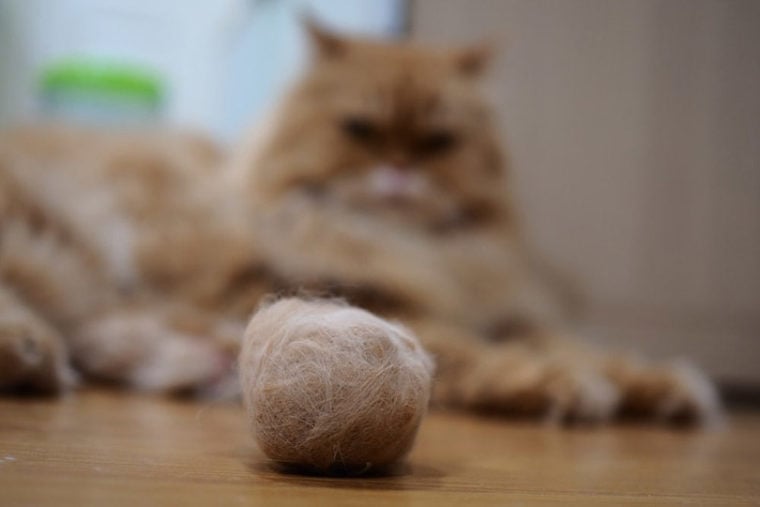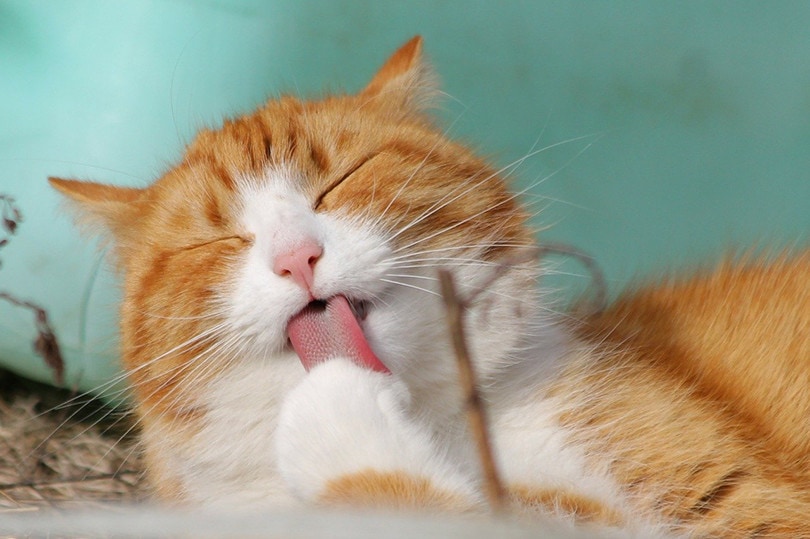
While this article discusses what you, as a cat parent, can do to help prevent problems with hairballs, home remedies are not an alternative to professional medical advice. If your pet has a serious issue, please consult your veterinarian immediately.
What Are Hairballs?
Most cats groom themselves regularly. Indeed, a lack of grooming usually indicates that there is a problem. A cat’s tongue is very effective at removing loose hair, dirt, and debris from their coat due to the presence of backward-facing barbs. This hair is then swallowed. Sometimes, it just passes through their digestive system with no trouble, but if it accumulates in a clump, this results in a hairball. Mostly, hairballs are vomited up without any complication, but they can sometimes cause problems due to obstruction of the digestive tract.
The 4 Home Remedies for Cat Hairballs
Pet parents can do some things to reduce the chances of hairballs developing, with the caveat, of course, that they should seek veterinary advice if they have any health concerns about their cat.
1. Grooming
One of the simplest and most effective things a pet parent can do to help prevent hairballs is to groom their cat thoroughly, especially if they have a long-haired breed. There are a wide range of brushes available, and grooming also provides cat parents with the opportunity to bond with their pet, as well as pick up on any lumps or bumps that may not be noticed otherwise. Most pet shops will stock grooming brushes.
Regular grooming of long-haired cats will aid in keeping the coat free of matts and tangles and help prevent hairballs. Veterinarians sometimes need to sedate cats to de-matt them thoroughly, so a simple task such as regular grooming can help avoid the use of sedation, as well as add to your pet’s comfort and reduce the risk of hairballs.
2. Diet
There are diets available that are designed to minimize the formation of hairballs. They contain a mixture of fibers that help to eliminate hair from the digestive tract. They may also contain essential fatty acids, proteins, and vitamins that improve skin and hair health. Discuss any dietary changes with your veterinarian first.

3. Hairball pastes
There are also commercially available hairball pastes. They contain various combinations of laxatives and lubricants that help to eliminate swallowed hairs from your cat’s digestive tract and are easy to administer. As with any supplement, seek advice from your veterinarian first.
4. Decreasing stimuli to grooming or over-grooming
While most healthy cats will groom regularly, over-grooming can be a problem in some. Regardless of the cause, over-grooming increases their ingestion of hair and consequently increases their chances of developing hairballs. Therefore, It is prudent for pet parents to be aware of the potential causes of over-grooming and take steps to prevent it. Apart from increased hair intake and hairball formation, it is beneficial for your cat’s overall health to have any underlying causes identified and treated.

Possible Causes
Parasites
Regular preventative treatment for fleas and other external parasites can help. Cats that go out and about are especially vulnerable to flea infestations and other parasites. The itch incited by these parasites can lead to over-grooming. In cats that suffer from flea allergic dermatitis, flea bites can lead to intense irritation, followed by massive over-grooming, sometimes bleeding skin and infection.
Regular parasite treatment is always advisable, although it should be noted that products are not always 100% effective. If your cat does become infested with fleas, he or she should be treated as soon as possible, alongside their environment and any other pets in the household.
A vast array of parasite treatments are available, with different modes of action. Seek your veterinarian’s advice on which is the most appropriate for your cat.
Allergic skin disease
Although an allergy to flea saliva is the most common allergy in cats, there are other things they can be allergic to, which can also lead to itching and increased intake of hair as they seek to relieve their irritation. A byproduct of keeping allergic skin disease under control, thereby relieving your cat’s intense discomfort, is reduced hair intake due to excessive grooming.
Sources of stress
Over-grooming can also be due to behavioral issues. If physical causes of over-grooming are eliminated, then the possibility of it being a behavioral problem must be considered. Try to identify and, if possible, eliminate potential sources of stress in your cat’s environment. There are also various nutraceuticals and pheromone-based products that are thought to help reduce stress in cats. Again, as with any supplementation, seek veterinary advice first.

When to See Your Veterinarian
The average frequency a cat will bring up hairballs is about once or twice a month. They may gag and retch before vomiting up a hairball. Although round in the stomach, they are usually tubular, cigar-shaped structures after they have been eliminated from the body due to their passage through the esophagus. Your cat may gag and retch a few times before a hairball emerges, but if you notice your cat repeatedly retching and gagging unproductively, you must have them examined by a veterinarian.
Hairballs can, on occasion, obstruct the digestive tract, typically in the small intestine but sometimes elsewhere. Obstruction is life-threatening and needs to be treated quickly. Apart from unproductive retching or gagging, other signs to look out for are loss of appetite, constipation or diarrhea, and a painful abdomen. Veterinary advice should be sought quickly if these signs or anything else is noticed. While they may not be due to obstruction, there are several other serious problems they may be indicative of, so veterinary attention is warranted if noted.
Your veterinarian will take a history from you, examine your cat, and is likely to advise further diagnostic tests such as X-rays, or bloods tests If an obstruction is thought to be likely based on the history, clinical examination, and diagnostic tests, then surgical intervention and removal of the obstruction is advised.
Conclusion
Being fastidious groomers, cats are prone to ingesting a lot of their own hair. While most of it should pass through the gut and be excreted in their feces, sometimes it can accumulate in their stomach and form a hairball. By following some basic home remedies pet parents can help reduce the likelihood of hairball development. However, veterinary advice should always be sought if you have any health concerns for your pet.
You Might Also Be Interested In:
- Why Does Dog Pee Kill Grass? 5 Ways to Prevent This
- 10 Best Hairball Remedies for Cats: Reviews & Top Picks
Featured Image Credit: Montakan Wannasri, Shutterstock







